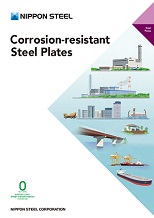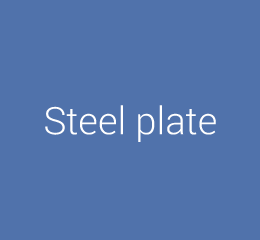
News
- Oct. 31, 2024
Launch of the overseas version of ProStruct™, a solution brand for the construction industry
—Expanding the packaged series of steel materials and solution technology to overseas construction markets— - Oct. 30, 2024 Participation in the Japan Pavilion at ADIPEC, the Energy-Related Exhibition in the Middle East
- Oct. 07, 2024 Nippon Steel Obtained SuMPO EPD (Formerly EcoLeaf) Certificationsfor Its Hot Extruded Steel Shapes
- Jul. 10, 2024 Long-term OCTG supply contract with Aker BP renewed –Strengthens strategic partnership through stable supply of OCTG–
- Jul. 03, 2024 Long-term OCTG supply contract with Equinor renewed –Strengthens strategic partnership through stable supply of OCTG–
- Jun. 14, 2024 Acceptance of Orders for High-Alloy Seamless OCTG and Employment of Green Steel “NSCarbolex Neutral” Finalized for CCS to Be Used in Construction Project for Blue Ammonia Manufacturing Plant in the State of Qatar
- May. 15, 2024 Adoption of Coating Cycle Extension Steel “CORSPACE” for the First Time in Overseas ODA Bridge Construction
- Apr. 23, 2024 Participation in OTC, an Energy-Related Exhibition in the U.S.
- Mar. 22, 2024 Designing Titanium TranTixxii wins the European “iF DESIGN AWARD 2024” —The world's first non-ferrous metal material to receive the award—
- Sep. 28, 2023 The Adoption of “NSCarbolex Neutral” steel product for geothermal project in the Netherlands operated by 85 Degrees Renewables.
- Mar. 11, 2022 Nippon Steel's TranTixxii and NIPPON STEEL Stainless Steel Corporation's NSSC220M featured on the roof of an international conference center in Jiangsu, China
- April 22, 2021 Nippon Steel to Launch ZAM®-EX high corrosion resistant coated steel sheets for overseas markets
- Oct. 01, 2020 Our new product "FeLuceTM" (hairline-finished electroplated steel sheet) wins the Good Design Award 2020 ~Our first steel sheet to win the Good Design Award~
- Feb. 14, 2019 NSSMC Receives Shell’s Supplier Award
- Jul. 30, 2018 Execution of Strategic Partnership with BP Oman
- Jul. 30, 2018 "The beauty of distinctive gradations make people feel nature" was posted.
- Jul. 26, 2018 VAM® 21 HT CLEANWELL® DRY ST First Running
- Jul. 19, 2018 Steel Wires Joint Venture Company for Cold Heading and Forging in USA (NSCI) holds an Opening Ceremony
- Jun. 27, 2018 NSSMC and Standard Steel Receive TTX “Excellent Supplier 2017” Award
- May. 29, 2018 NSSMC Named a Top 100 Global Innovator in 2017 for Sixth Consecutive Year
- Apr. 25, 2018 Steel Wires Joint Venture Company for Cold Heading and Forging in USA (NSCI) Starts Commercial Production
- Apr. 17, 2018 Strengthening Supply System for Ultra-high-tensile Steel Sheets New CGL to be installed at Kimitsu Works
- Feb. 27, 2018 Nippon Steel & Sumikin Crankshaft, NSSMC’s manufacturing and sales subsidiary of crankshafts in the U.S., earns Diamond Supplier Award from Navistar
- Aug. 04, 2017 NSSMC’s proprietary titanium product TranTixxii™ is adopted for cladding of a theater in Jiangsu Province, China
S-TEN™
Recently, environmental issues are becoming pressing concerns. In parallel with this, construction of
tall smokestacks, air preheaters, electrostatic precipitators and flue-gas desulfurizers and other
treatment equipment has shown great strides.
Meanwhile, the mainstay industrial fuel has shifted from conventional coal to heavy oil, which poses a
large problem of corrosion at the low-temperature section of flue-gas treatment equipment (in
particular, air preheaters, flues and smokestacks) due to sulfur oxides.
The low-temperature section corrosion is the corrosion caused by high-temperature, highly-concentrated
sulfuric acid, called sulfuric acid dew-point corrosion. This kind of corrosion differs from general
atmospheric corrosion and causes heavy corrosion of not only ordinary steel but even stainless
steel.
Further, because of the remarkable technological developments recently seen in dioxin countermeasures,
flue-gas temperatures are increasingly being reduced from previous levels.
In conventional facilities where, formerly, only sulfuric acid dew-point corrosion occurred, there are
now cases of hydrochloric acid dew-point corrosion that is caused by lower flue-gas temperatures
resulting from remodeling with countermeasures against dioxins.
Developed to solve these problems is S-TEN—steel for welded structures, highly resistant to
sulfuric acid and hydrochloric acid dew-point corrosion.
S-TEN 1 has effective resistance to both sulfuric acid dew point corrosion and hydrochloric acid dew
point corrosion, while S-TEN 2 is effectively resistant to sulfuric acid dew point corrosion.
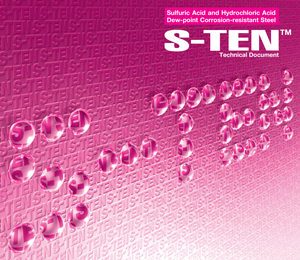
Features
S-TEN is a sulfuric acid and hydrochloric acid dew-point corrosion-resistant steel developed by NIPPON STEEL using proprietary technology.
- S-TEN exhibits the best resistance to sulfuric acid and hydrochloric acid dew-point corrosion found in the flue-gas treatment equipment used with coal-fired boilers, waste incineration plants, etc. (This steel has the finest application record in the field of thermal power generation and waste incineration plants, according to surveys conducted by NIPPON STEEL)
- S-TEN was awarded the Ichimura Industrial Award Achivement Award in 2007
S-TEN has strength, workability and weldability that are comparable to ordinary steel.
S-TEN is more economical than stainless steel.
S-TEN offers a rich product line ranging from hot-rolled sheets (plates), cold-rolled sheets and pipe and tubes to welding materials.
- Hot-rolled sheets (plates) conform to JIS G 3106 SM400A (S-TEN 1) and SM490A (S-TEN 2).
S-TEN products are easily available because they are constantly stocked by retailer
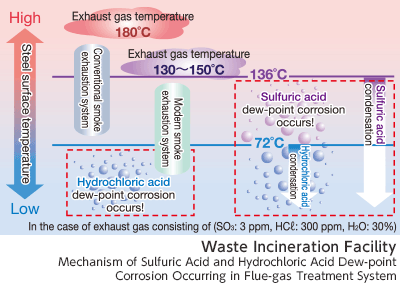
Application Examples for S-TEN
| Equipment | Practical application examples | Precautions in use | |||
|---|---|---|---|---|---|
| Application | Grade | Approximate plate thickness (mm) | |||
| S-TEN 1 | S-TEN 2 | ||||
| Dry-type electrostatic precipitator | Casing, duct, collecting electrode | ○ | ○ | 1.2~8 | The temperature of casings and ducts is 20~70℃ lower than that of flue gas, depending on the heat insulation conditions. It is estimated that the temperature of the collecting electrode and the gas is the same. In cases when dust accumulates, the absorbed H2SO4 is difficult to evaporate and leads to cases of more than expected corrosion. As a result, it is necessary to prevent dust accumulation. |
| Wet-type electrostatic precipitator | Casing, duct, collecting electrode | ○ | ○ | 3.2~12 | In cases when the flow of scrubber water is constant against a wall surface, the corrosion mass increases (by 0.1 mm/yr on one side). Further, in cases when the scrubber water in such a situation has a low pH value, the corrosion mass will increase abruptly, thereby making it necessary to avoid the use of S-TEN. |
| Gas cooler | Casing, duct | ○ | ○ | 4.5~9 | The temperature of casings and ducts is 20~70℃ lower than that of flue gas, depending on the heat insulation conditions. The mist droplet becomes large due to the deterioration of nozzle holes and does not evaporate to reach the casing, under which there are cases when unexpected corrosion occurs, and thus it is necessary to control the deterioration of nozzle holes. |
| Ash discharge blade | - | ○ | 12~20 | S-TEN 2 is most suitable for use as the material for the blades that discharge the ash accumulated in the bottom section of gas cooler. The stress-induced corrosion cracking attributable to the chlorides contained in the ash can be prevented from occurring. | |
| Air preheater |
Ljungströmtype basket case, element | ○ | ○ | 0.6~6 | Because of repeated fluctuations in wall surface temperature, dew-point corrosion from high to low temperatures occurs repeatedly, and the application advantage of S-TEN is exhibited to the high degree. |
| Tube | ○ | - | 0.6~3.5 | The tubes are constantly in the dew-point state, and accordingly, S-TEN is highly effective. S-TEN 1 tube is most suitable for such application. | |
| Flue | Duct, expansion | ○ | ○ | 4.5~9 | S-TEN of the no coating specifications or the acid resistantcoating specifications is suitable. When the temperature of the flue gas itself drops below the dew point, drainage accumulates in the flue bottom, frequently causing unexpectedly severe corrosion, and thus it is recommended to provide appropriate measures to carry out sufficient drainage and to prevent lowering of steel plate temperatures by means of external heat insulation. |
| Stack | Internal cylinder | ○ | - | 6~12 | |
| Flue-gas desulfurizer | Flue-gas cylinder, after-burner duct | ○ | ○ | 3.2~6 | In the ducts leading to and from gas coolers and absorption towers, low pH solutions occasionally adhere to wall surfaces due to sulfuric acid mist, and therefore it is necessary to fully investigate drainage conditions. |
| Hydrochloric acid pickling tank | Tank | ○ | - | 9~20 | The use for hydrochloric acid pickling tank in coating is suitable. S-TEN tanks have a high scratch resistance during use, and these tanks after use can be treated as the general recyclable steel material. |
Precaution in the Use of S-TEN
- S-TEN are a group of low-alloy corrosion-resistant steels. It should be noted that despite dew point corrosion being inhibited in them, there still occurs rust formation and progress of corrosion also.
- S-TEN, as shown in Fig. 1.6, are effective in inhibiting sulfuric acid dew point corrosion, as compared with other steel grades, but, as can beseen from their performance at 60°C and 70°C in this figure, there are temperature regions in which steels’ absolute corrosion weight losses become greater than those in the other temperature regions.
- Careful note must be taken of the fact that S-TEN also tend to be more greatly susceptible to high-temperature corrosion and low-concentration sulfuric acid corrosion, than to corrosion occurring in the gas-liquid equilibrium state, as shown in Fig. 1.10.
- Results of the corrosion test made at very thin concentrations of pH2 to 4 of sulfuric acid are shown in Table 1.8. As against corrosion by such weakly acidic or neutral liquid, stainless steels are most resistant, with very little corrosion weight loss. At concentrations of pH3 and over, there is no significant difference between ordinary steels and S-TEN.
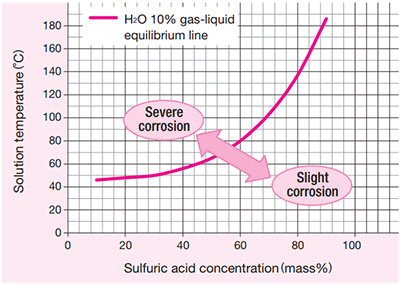
| Grade | Corrosion rate (mg/cm2/hrs) | Testing conditions | ||
|---|---|---|---|---|
| pH2 | pH3 | pH4 | ||
| S-TEN 1 | 1.6 | 2.0 | 0.36 | Test temperature: 30℃ Relative speed of specimen and solution: 1.8 m/sec Test time: 72 hrs |
| S-TEN 2 | 2.8 | 2.2 | 0.38 | |
| Mild Steel | 8.2 | 2.5 | 0.36 | |
| SUS 304 | < 0.001 | < 0.001 | < 0.001 | |
| SUS 316 | < 0.001 | < 0.001 | < 0.001 | |
| SUS 410 | 0.51 | < 0.001 | < 0.001 | |
| SUS 430 | 0.001 | < 0.001 | < 0.001 | |
Application Examples
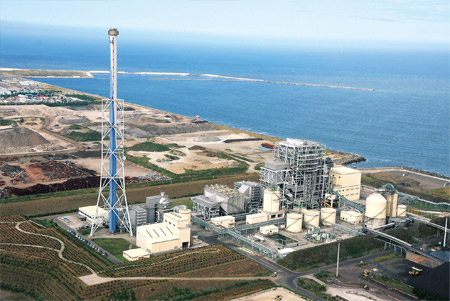
Catalogs
Sulfuric Acid and Hydrochloric Acid Dew-point Corrosion-resistant Steel
S-TEN™ (1.74MB)![]()
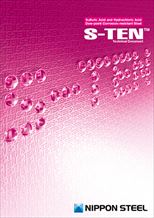
- 1. Characteristics of S-TEN
- Sulfuric Acid and Hydrochloric Acid Dew-point Corrosion
- Advantages of S-TEN
- Examinations in Applying S-TEN
- Application Examples for S-TEN
- Precautions in the Use of S-TEN
- 2. Specifications and Available Sizes of S-TEN
- Specifications of S-TEN
- Available Sizes for S-TEN
- 3. Characteristic Properties of S-TEN (Examples)
- Chemical Composition and Mechanical Properties
- High-Temperature Characteristics
- Physical Properties
- Corrosion Resistance
- 4. Welding of S-TEN
- Welding Materials
- Welding Characteristics
- Sulfuric Acid and Hydrochloric Acid Resistance of Welded Joints
- Galvanic Corrosion in Corrosive Atmosphere
- Property Qualification Test Results
- 5. Application Examples
- 6. Reference
- Unit Conversion Table
- Unit Conversion Charts
NIPPON STEEL’s Steel Products for Thermal Power Generation (4.30MB)![]()
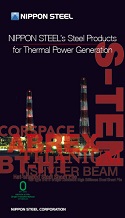
- Proposing NIPPON STEEL's eco-friendly steel products for power plants
- S-TENTM
- BT-HT
- CORSPACETM
- ABREXTM
- TITANIUM
- NSHYPER BEAMTM
- Hat-shaped Steel Sheet Pile / Hat-type and H-shape Combined High Stiffness Steel Sheet Pile
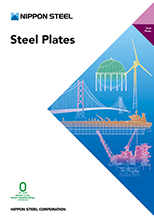
- Features
- Available Grades
- Authorized Steel Grades by Product Type
- Manufacturing Process and Quality Control Points
- Thermo-Mechanical Control Process (TMCP)
- 400 N/mm2-class Tensile Strength Steel Plates (As-rolled) Available Sizes
- 490 N/mm2-class Tensile Strength Steel Plates (As-rolled) Available Sizes
- 490 N/mm2-class Tensile Strength Steel Plates (TMCP: Thermo-Mechanical Control Process) Available Sizes
- Weldable High-tensile Strength Steel Plates: WEL-TENTM Series
- Abrasion-resistant Steel Plates: ABREXTM Series
- Abrasion-resistant Steel Plates for Low Temperatures: ABREXTM LT Series
- Low-temperature Steel Plates: N-TUFTM Series
- Sulfuric Acid-resisting Steel Plates: S-TENTM Series
- Ni-Added Weathering Steel Plates: NAW-TENTM Series
- Highly Corrosion-resisting Steel Plates: COR-TENTM Series
- Corrosion-resistant Steel Plates for Export: COR-TENTM
- High Tensile Steel Plates for Building Structures: BT–HT Series
- Steel Plates for Elasto-plastic Hysteretic-type Dampers for Building Structures: BT-LYPTM
- Electromagnetic Mild Steel Plates: NS–MIPTM
- Information Required for Orders
- Examples of Marking
- Conclusions
- Reference for Use of Steel Plates
- Reference Tables of Standards
- NIPPON STEEL Specifications Table of Correlations between Old and New Specifications
Contact Information
For further product information
Product Quotes, and inquiries without complete information required in inquiry form may not be responded to. Selection of inquiries for reply online is at the sole discretion of NIPPON STEEL. We appreciate your understanding.
